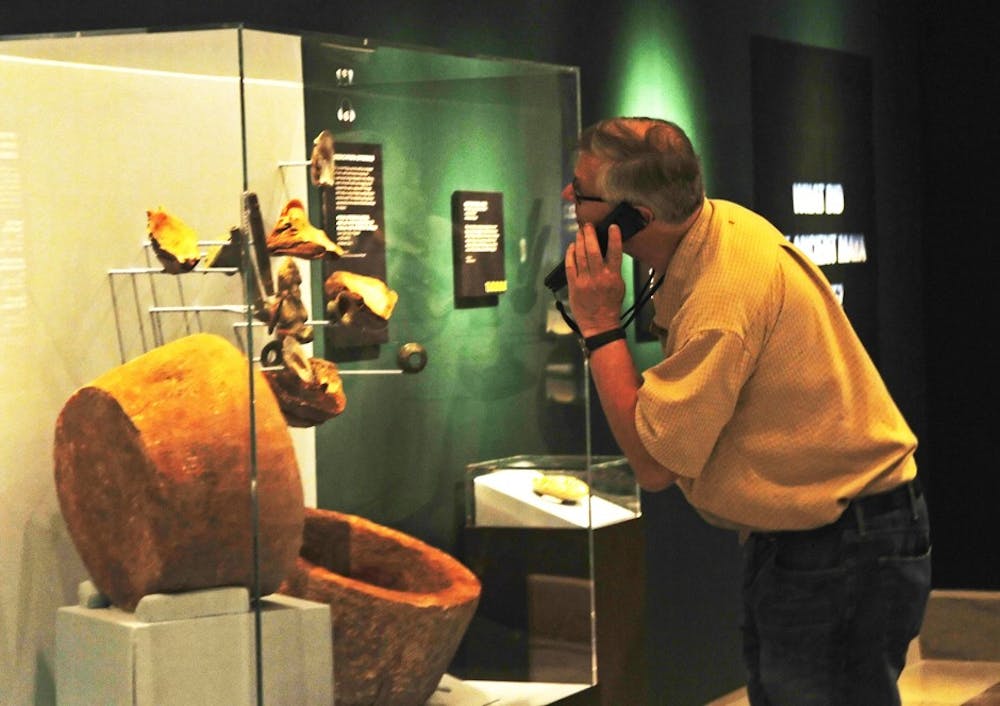
A 4000-year-old bound captive is one of the Penn Museum’s more unusual visitors this summer.
The ancient Egyptian stone statue will be on display until Aug. 5 as part of an “exchange of prisoners” between the Penn Museum of Archaeology and Anthropology and the Metropolitan Museum of Art.
When the Met requested several items, including a unique stone door socket also in the shape of a bound captive for its Dawn of Egyptian Art exhibit, the Penn Museum agreed with the condition of a temporary exchange from the Met’s collection. The “prisoners” are two of 10 artifacts exchanged between the museums.
Bringing fresh sights into the collections is part of the Museum’s recent efforts to revamp the experience for its visitors.
“Penn Museum is actively involved in loan programs with many museums,” Egyptian section curator Dr. David Silverman said. “Such activities allow institutions to augment their collections, create new exhibitions and provide more information to visitors.“
In its recent exhibits, the Museum has placed particular emphasis on interactive displays. The Maya 2012 exhibit, which runs from May 3 to Jan. 13, transforms discoveries from Penn archaeological work in Copan, Honduras into a wall-size timeline of Mayan history, as well as a glyph writing station.
“We strive to create challenging and engaging exhibitions that make connections in our daily lives,” Director of Exhibitions Kate Quinn said. “In this museum, you will find a wide variety of interpretive approaches to make material accessible.”
According to Quinn, the key is to tell a story.
“While some institutions use technology just for technology’s sake and others avoid it at all costs, the Penn Museum takes a different approach,” she said. “In our museum, story is first. You will find objects mixed with interactives, videos, audio, bold colors and strong graphics to aid in the telling of a story.”
In addition to its exhibits, the Museum hopes to further involve students in the work of the institution itself.
“Not only are we trying to bring students in to enjoy the galleries, but we’re really working more with students and professors to … do research in the collections,” Kosty said. “We’re encouraging professors to take advantage of [the Museum] and let students have firsthand opportunities to see artifacts that relate to what they’re studying.”
Historical Archaeology section curator Professor Robert Schuyler, who incorporates the Museum’s collections and labs into his archaeology classes, believes the Museum’s vitality stems from its ties to research and discovery.
“If the Museum is not primarily a research center, then it’s generating no new information — it’s simply taking information from other centers or it’s manipulating older information,” Schuyler said. “Whereas if it’s a research center, then it can more intimately involve both students and the public in the process of research itself.”
In order to modernize its exhibits, the Museum has also launched an online database, which allows users to see detailed information on more than 600,000 Museum artifacts. The database, which was created this year, enables visitors to share their own collections of works online.
“The online database’s target audiences go beyond our museum visitors, allowing anyone … an opportunity to see what we have and make use of it in their own way [such as] research, teaching or personal interest,” Museum Chief of Staff Dr. James Mathieu said.
In addition, the Museum has expanded its online presence with a blog, Facebook page, YouTube channel, lecture recordings on iTunes and a Twitter represented by Phil the Sphinx, the third-largest sphinx in the world who resides in the Museum.
Students have taken notice of the Museum’s efforts to revitalize its offerings. Rising College sophomore Josh Bryer said that while some may find museums to be dry, his experience with the Penn Museum has been far from dull.
“I feel like this museum has a lot of personality to it,” he said. “I’ve been four or five times and every time there’s always something I pick up on that I haven’t before. I think the general opinion is that those who know about it love it.”
Part of this, according to Bryer, comes from the Museum’s recent efforts to extend the experience beyond simple exhibits. He noted that special exhibits such as Maya 2012 and last year’s Secrets of the Silk Road add interest to the museum.
“The temporary exhibits help bring in different aspects of the culture, like the Secrets of the Silk Road brought in mummies from China,” Bryer said.
Though some students feel the Museum still has work to do when it comes to engaging students, they appreciate its use of new technology and media.
“I think that when most Penn students consider the Museum, they think back to New Student Orientation and their toga-party memories,” rising College sophomore Helen Kim said. “The Museum should push past that. It can afford to promote itself a little better — social media like Twitter and Facebook are great ways to do just that.”
Keeping with its goals to energize the museum experience, the Museum is far from idle this summer. On Wednesdays mornings visitors can enjoy the morning Summer Wonder series — which includes musical performances and Aztec and Irish dance lessons — and stay for the PM @ Penn Museum Summer Nights program, which fills the Museum courtyard with international music every Wednesday evening.
The Daily Pennsylvanian is an independent, student-run newspaper. Please consider making a donation to support the coverage that shapes the University. Your generosity ensures a future of strong journalism at Penn.
DonatePlease note All comments are eligible for publication in The Daily Pennsylvanian.





